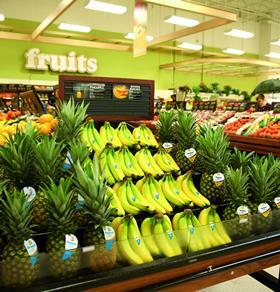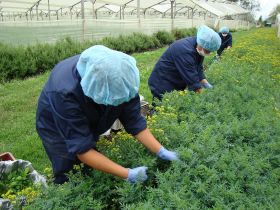
How important is the US market for Colombia’s fresh fruit and vegetable exports?
Ana Maria Hernandez: The US is our biggest export market and it has grown in importance since the US-Colombia free trade agreement was fully implemented in 2012. In the period between May 2012 and June 2014 Colombia’s food and agricultural exports to the US totalled US$3.4bn. During that time fruit and vegetable exports grew by 13.8 per cent compared with the same months between 2010 and 2012, reaching US$584m.
The main fruit export, bananas, rose by 13.7 per cent to US$518m, while sendings of other fruits and vegetables increased by 50.3 per cent, mainly due to the increase in exports of fresh herbs, limes, pineapples and physalis.
In 2013 exports of Colombian fresh fruits and vegetables to the US totalled US$276m, which represents 12 per cent of Colombia’s total agricultural exports. Being our main market, we believe there are still immense growth opportunities for the products mentioned above, as well as for new products like avocado, which we are currently working to secure access for. Colombian exporters feel they have only experienced the tip of the iceberg, and believe many other products could be developed over the coming years.
Other than bananas, what were the main products that were sent to the US last year?
AMH: The main products exported during 2013 were bananas and plantains, which together totalled US$255m, representing 92 per cent of total Colombian fruit and vegetable exports to the US. In second place is basil with US$4.9m, followed by yam (US$2m), mint with US$1.98m and pineapples with US$1.89m.
 Exports of other fresh vegetables reached US$1.59m. This includes thyme (US$917,629), limes (US$257,230) and onions and leeks (US$198,675), amongst others. It is important to highlight that fresh herbs, including some of the products listed above, add up to more than US$10m and are the second most important export to the US after bananas and plantains.
Exports of other fresh vegetables reached US$1.59m. This includes thyme (US$917,629), limes (US$257,230) and onions and leeks (US$198,675), amongst others. It is important to highlight that fresh herbs, including some of the products listed above, add up to more than US$10m and are the second most important export to the US after bananas and plantains.
Additionally, during January and May 2014, lime exports increased to more than US$2.5m and lemons reached US$578,934 –this latter being a sector in which Proexport actively supported companies wishing to take advantage of this commercial window that exists.
If you look at the figures for the first half of 2014 you will see that agricultural exports increased by 33 per cent compared to the same period last year, reaching a total of US$160m. Bananas are still the main product exported, but shipments of other fruits increased by 57.3 per cent during this period.
How many Colombian companies are due to take part in this year’s PMA Fresh Summit in Anaheim?
AMH: The Colombian Pavilion will house 22 companies this year. Among the products we are showcasing are Hass avocados, herbs, pineapples and limes. We’re also presenting a new product to the US market: physalis. People attending our booth will be able to taste this new super food and learn about its health benefits. Colombia has just gained approval to ship physalis produced in specific areas of the country to the US without subjecting it to cold treatment.
What are you hoping to get out of the event?
AMH: We want to promote Colombia as a competitive supplier of the fruits and vegetables mentioned above, as well as a potential ally for the development of other categories, taking advantage of the benefits of the free trade agreement. As I said before, a key focus will be the recent introduction of physalis to the US market, a fruit we are very keen to promote given its excellent health and nutritional benefits.
What other activities does Proexport undertake in the US to promote Colombian-grown fruits and vegetables?
 AMH: As well as supporting companies by assisting them in developing business opportunities when attending different events such as the PMA Fresh Summit Proexport works with exporters to develop different marketing and communication strategies to help introduce new fruits, like physalis. We organise trips for buyers and exporters, both in Colombia and the US, so they can learn about the latest market trends and the opportunities that exist. Lastly, we develop additional promotional activities to help Colombian exporters position their products in the US market.
AMH: As well as supporting companies by assisting them in developing business opportunities when attending different events such as the PMA Fresh Summit Proexport works with exporters to develop different marketing and communication strategies to help introduce new fruits, like physalis. We organise trips for buyers and exporters, both in Colombia and the US, so they can learn about the latest market trends and the opportunities that exist. Lastly, we develop additional promotional activities to help Colombian exporters position their products in the US market.
Where do you see the biggest opportunities for growth in the years ahead? What particular market niches is Colombia looking to fill?
AMH: We are interested in taking Colombian products to grocery stores that specialise in natural and organic produce, such as Fresh Market and Whole foods. For example, the fact that Colombia is able to export physalis to the US without it being subjected to cold treatment has opened up significant possibilities for this product as it means we can reach the market with competitive prices. Provided we can successfully communicate the nutritional benefits this super food has to offer to consumers we believe it has a big future.
We also have high expectations for our Hass avocados once we get the green light to start shipments to the US. We already export this product to Europe so we’ve built up the experience and the technical know-how to enable us to establish a successful programme in the US.
Thanks to its geographical location Colombia has an advantage over other South American suppliers, especially when it comes to targeting the East Coast. We expect to see an increase in shipments of several products including pineapples, fresh herbs and limes and in future years we hope to introduce new products such as melons and a number of exotic fruits for which we are currently working to secure access.






No comments yet